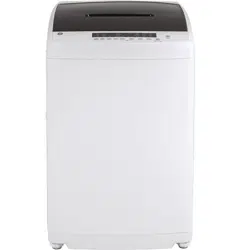Documents: Go to download!
User Manual
- User Manual - (English, French, Spanish)
- Specification - (English)
- Energy Guide - (English)
OWNER’S MANUAL & INSTALLATION INSTRUCTIONS WASHERS
USING THE WASHER
Getting started
Throughout this manual, features and appearance may vary from your model.
Step 1. IMPORTANT : See the dispenser section in this manual.
- Add fabric softener to the fabric softener dispenser.
- Add the manufacturer’s recommended amount of detergent. GE Appliances recommends the use of High Efficiency detergents such as
 in your energy efficient washer. Place detergent pods in the bottom of the wash basket before adding clothes.
in your energy efficient washer. Place detergent pods in the bottom of the wash basket before adding clothes.
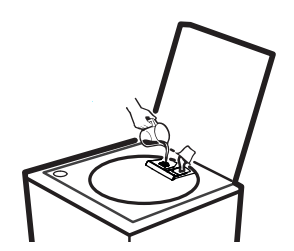
Step 2
- Loosely add items around Infusor. Overloading may negatively impact wash performance. See page 10 for suggested loading examples.
- Close lid.
NOTE: The washer will not start with lid open.

Step 3
- Select wash cycle.
- Select wash options, including Deep Rinse option when using fabric softener.
- Select options.
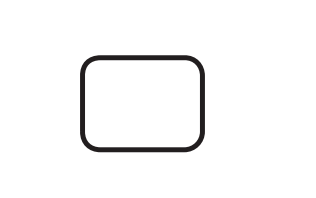
Step 4
- Press Start.
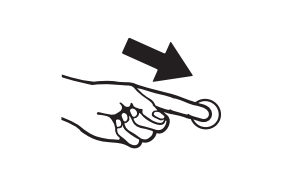

A. Power
Press Power to “wake up” the display. If the display is active, press Power to put the washer into idle mode. NOTE: Pressing Power does not disconnect the appliance from the power supply
B. Start/Pause
Press Start to begin the cycle. If the washer is running, pressing it once will pause the washer.
C. Display
The display shows the approximate time remaining until the end of the cycle. NOTE: The cycle time is affected by how long it takes the washer to fill. This depends on the water pressure in your home. The size of the load being washed also significantly impacts cycle time, with larger loads taking longer.
D. Cycle
Press the Cycle button to select the desired cycle. The chart below will help you match the items to be washed with the best wash cycle settings. For optimal performance, select the cycle that most closely matches the items being washed.
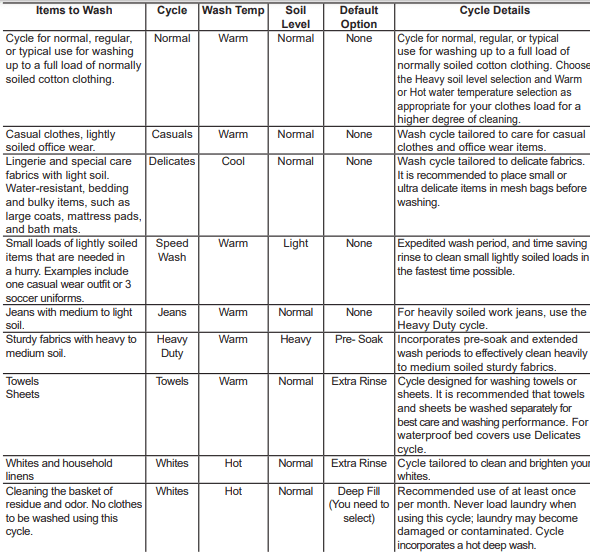
E. Settings
Individual settings for agitation (Soil), water temperature (Temp), and spin (Extra Spin) can be set from the minimum (lowest in column) to maximum (highest in column). In general, the higher up the column, the more washer energy will be used. NOTE: Extra Spin typically reduces dryer time/energy usage (i.e. reduces total energy when using both a washer and a dryer).
F. Delay Wash
Press Delay Wash to choose the number of hours you want to delay the start of the cycle, and then press Start/Pause. The washer will count down and start automatically at the correct time.
G. Signal
To turn the signal sounds on/off, press Signal.
H. Cycle Options
Extra Spin
Set this option to increase the spin time of the cycle.
Pre-Soak
Select the Pre-Soak feature to add a soak step following the fill portion of the cycle.
Extra Rinse
When you use extra detergent or bleach to clean heavily soiled clothes, use the Extra Rinse option to better remove additional residues.
Deep Fill
Select the Deep Fill feature for loads where extra water is needed. The Deep Fill feature is recommended for special case loads only, not for typical use. NOTE: This option is not allowed for some cycles.
Deep Rinse
Set this option to provide a deep rinse or when using fabric softener.
I. Control Lock
Use the control lock before or during a cycle to prevent any selections from being made. To lock/unlock the washer controls, press and hold the Signal and Delay Wash buttons for 3 seconds.
J. Process
Choose the wash processes to include in the cycle. Press Process until all the processes you want to include are lit. More than one process can be selected.
Soak
Select to set a soak process only. Washer basket will fill, soak, and drain.
Wash
Select to set a wash process only. Washer basket will fill, wash, and drain.
Rinse
Select to set a rinse process only. Washer basket will rinse and spin.
Spin
Select to set a spin process only. Washer basket will spin.
Consumer Help Indicator
Your washer is equipped with Consumer Help Indicator (CHI). CHI is our way to communicate a simple remedy for some situations that you can perform without the need to call for service. The chart below describes the helpful messages you may notice on your display when you return to start another load. These messages will provide simple remedies you can quickly perform.
Spin light blinking : If an out-of-balance condition is detected by the washer, the Spin light will blink during the remaining portion of the cycle and will stay illuminated for a short time after cycle completion. When this occurs, the washer is taking actions to correct the out-of-balance condition and complete the cycle normally. In some cases, the washer may not be able to balance the load and spin up to full speed. If you notice the load is more wet than normal at the end of the cycle, redistribute the load evenly in the wash basket and run a Spin cycle. To run a Spin cycle, select the Normal cycle and press the Process button until only the Spin light is on.
 : Check your house water supply. Did you forget to turn on one or both supply valves after installation or coming back from vacation?
: Check your house water supply. Did you forget to turn on one or both supply valves after installation or coming back from vacation?
 : Indicates the lid is open. Close the lid.
: Indicates the lid is open. Close the lid.
 : Indicates the laundry load is unbalanced. Reposition laundry evenly in basket, and ensure washer is level.
: Indicates the laundry load is unbalanced. Reposition laundry evenly in basket, and ensure washer is level.
 : Indicates water has reached a critical level. Turn off water and power to the washer and call service.
: Indicates water has reached a critical level. Turn off water and power to the washer and call service.
Detergent Dispenser
HE detergent should be added to the left side of the dispenser drawer. For liquid detergent, leave cup in drawer. For powder detergent, remove left cup (two parts) from drawer. Follow the detergent manufacturer’s recommendations for the correct amount of detergent, based on load size, taking care to add detergent to the left compartment. Do not overfill or dilute detergent as this can result in additive being dispensed prematurely in the wash cycle. Your option selections will determine when detergent is automatically dispensed at its optimal time in the wash cycle. For optimal performance, especially when selecting cooler temperature and in cold weather climates, place powdered HE detergent directly in the wash basket before adding clothes. NOTE: Single-dose laundry packets should not be added to the dispenser drawer, as they will not dispense properly. Put packets in bottom of wash basket.
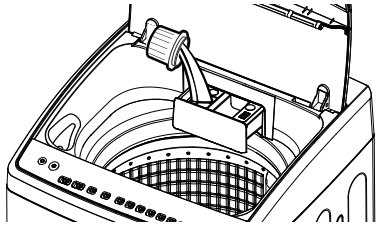
For liquid detergent, leave cup in drawer, and pour into left cup/compartment

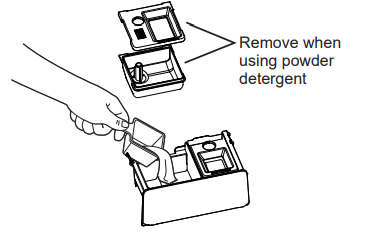
For powder detergent, remove left cup (two parts) from drawer, and pour into left compartment.
Liquid Fabric Softener/Conditioner Dispenser
Deep Rinse should be selected when using fabric softener. Liquid fabric softener/conditioner should be added to the right side of the dispenser drawer. Follow the liquid fabric softener/ conditioner manufacturer’s recommendations for the correct amount of softener/conditioner, based on load size, taking care to add softener/conditioner to the right compartment. Do not overfill or dilute softener/conditioner as this can result in additive being dispensed prematurely in the wash cycle. Your option selections will determine when liquid fabric softener/conditioner is automatically dispensed at its optimal time in the rinse cycle. NOTE: Fabric softener crystals should NOT be added to the dispenser drawer, as they will not dispense properly.

Liquid Bleach Dispenser
Liquid chlorine bleach should be added through the bleach dispenser in the front left corner. Follow bleach manufacturer’s recommendations for the correct amount of liquid chlorine bleach based on load size, taking care to not apply or spill it directly on clothing. NOTE: Do not use liquid chlorine bleach and laundry pretreatments such as an Oxi product in the same wash load.
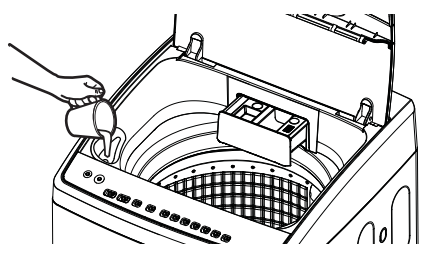
Loading
Automatic Load Sensing
This determines the correct agitate profile, agitate duration, and amount of water suited to the size and type of load placed in the washer. The washer will not start the wash cycle or fill with water if the lid is open. When the lid is closed the machine is able to begin filling with water in order to sense the load size. NOTE: Automatic load sensing initiates pulses of the motor at the beginning of the cycle. This is a normal operation. NOTE: This is a high-efficiency washing machine. This system requires less water while providing effective cleaning action. You may notice that the water level is lower than on your previous washer. This is normal for a high-efficiency washer.
Pretreatment
Place laundry pretreatments, such as an Oxi product, directly in the bottom of the wash basket before loading clothes. NOTE: Do not use liquid chlorine bleach and laundry pretreatments such as an Oxi product in the same wash load.
Proper Use of Detergent
Using too little or too much detergent is a common cause of laundry problems. Use less detergent if you have soft water, a smaller load or a lightly soiled load. For spots, apply pre-treatment to items as recommended on the product label. Application should be made in the basket to prevent overspray which may cause the coloring on the lid or graphics to fade. Place detergent pods in the bottom of the wash basket before adding clothes.
GE Appliances recommends the use of High Efficiency detergents such as  in your energy efficient washer. HE detergents are formulated to work with low water wash and rinse systems. HE detergents reduce the oversudsing problems commonly associated with regular detergents. When using high efficiency or concentrated detergents, consult the product label to determine amount required for optimum performance. Excessive detergent will negatively impact wash performance.
in your energy efficient washer. HE detergents are formulated to work with low water wash and rinse systems. HE detergents reduce the oversudsing problems commonly associated with regular detergents. When using high efficiency or concentrated detergents, consult the product label to determine amount required for optimum performance. Excessive detergent will negatively impact wash performance.
Sorting Wash Loads
Sort by color (whites, lights, colors), soil level, fabric type (sturdy cottons, easy care, delicates) and whether the fabric produces lint (terry cloth, chenille) or collects lint (velveteen, corduroy). Wash lint producers such as cotton towels and socks separate from lint collectors including synthetic garments and dress pants.
Loading the Washer
Load dry items loosely in the washer basket. For best results, load items evenly and loosely around the outside of the basket, filling in towards the center on larger loads. To add items after washer has started, press Start/Pause. Lift the lid and submerge additional items around the outside of the basket. Close the lid and press Start to resume.
- Do not place large items such as sheets, blankets and towels across the Infusor. Load them around the outside of the basket.
- Do not put lawn or sofa cushions into the washer as they are too big to move. Remove outer covers and ONLY wash them.

CARE AND CLEANING
Exterior of the Washer
Immediately wipe off any spills with a damp cloth
Interior of the Washer
To clean the interior of the washer, select the Whites cycle and Deep Fill option on the control panel. A basket clean cycle should be performed, at a minimum, once per month. This cycle will use more water, in addition to bleach, to control the rate at which soils and detergents may accumulate in your washer.
NOTE: Read the instructions below completely before starting the basket clean cycle.
1. Remove any garments or objects from the washer and ensure the washer basket is empty.
2. Open the washer lid and pour 1/2 cup or 125 ml of liquid bleach or other washing machine cleaner into the basket.

3. Close the lid, select the Whites cycle, and the Deep Fill option. Push the Start button.
4. When the basket clean cycle is working, the display will show the estimated cycle time remaining. Do not interrupt the cycle. If interrupted, be sure to run a complete basket clean cycle before using the washer.
IMPORTANT:
- Run this cycle with 1/2 cup (125 ml) of bleach once a month.
- After the completion of a basket clean cycle, the interior of your washer may have a bleach smell.
Lint Filter
Clean EVERY MONTH to remove any items that may have been caught in the filter.
1. Remove the blue lint filters from the side of the basket by unclipping.
2. Open the filter, gently remove lint, rinse filter in warm water, and close.
3. Replace by snapping filter back into its location in the washer basket.
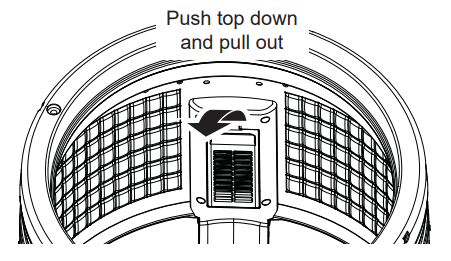
Dispenser Drawer
After some period of use, a small amount of detergent or softener residue may be present in the dispenser drawer. The drawer can easily be removed for cleaning. To remove the drawer, pull it out until the drawer stops and then lift up on the front of the drawer. The drawer can then be removed from the dispenser box. Wash the drawer in warm, soapy water using a mild detergent. Rinse drawer with warm water. If cups are removed for cleaning, be sure to push cups fully back into place after cleaning. The dispenser drawer and cups are not dishwasher safe. The dispenser box is not removable, but it can be wiped clean using a damp cloth if necessary. Do not attempt to remove the dispenser box for cleaning.

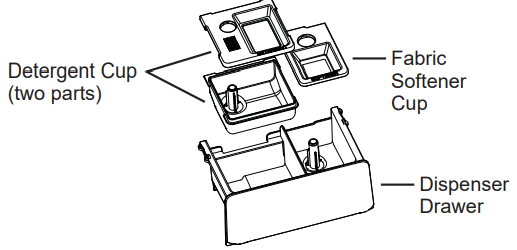
Inlet Water Valve Screen(s)
If the flow of entering water into the washer is slow, the inlet water valve screen(s) may be clogged. Check and clean inlet valve screens EVERY SIX MONTHS.
1. Turn off water valve(s).
2. Disconnect water hose(s) from the back of the washer.
3. Remove the screen(s), clean with a brush and replace.
4. Replace the hose(s).
5. Turn water valves on.
6. Check for leaks, tighten if necessary.
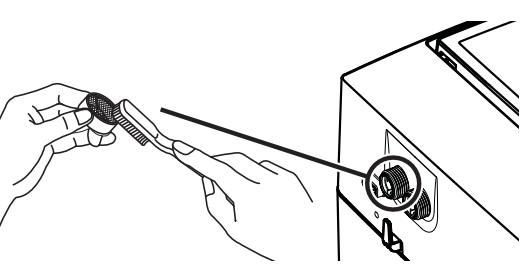
Water Supply Hoses
Hoses connecting washer to faucet should be replaced every 5 years.
Long Vacations
Be sure water supply is shut off at faucets. Drain all water from hoses and water filter pump area if weather will be below freezing.
Moving and Storage
Ask the service technician to remove water from drain pump and hoses. Do not store the washer where it will be exposed to the weather.
INSTALLATION INSTRUCTIONS
PARTS SUPPLIED
- Water Hoses (2) (Stationary models only)

- Uni-couple® Hose (Portable models only)
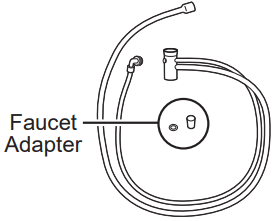
- Drain Hose

- Clamp

- Base Cover Kit
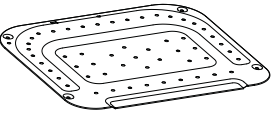
- Owner’s Reference Guide

TOOLS REQUIRED FOR WASHER INSTALLATION
- Pliers

- Level

- Phillips-Head Screwdriver

UNPACK THE WASHER
After the machine is in the home, remove outside packing material/carton from washer. Remove bag, drain hose and Owner's Reference Guide from tub. NOTE: Leave foam shipping material inside tub opening to hold tub in place during the rest of installation.

WATER SUPPLY REQUIREMENTS
WATER SUPPLY LINES - Purge Hot and Cold water supply lines for 30 seconds prior to installation of hoses and washing machine. Ensure inlet hose screens are also clean and free of debris. WATER PRESSURE - Must be 20 psi minimum to 120 psi maximum. WATER TEMPERATURE - The household water heater should be set to deliver water at 120° to 150°F (50° to 66°C) TO THE WASHER when the hot wash is selected. SHUTOFF VALVES - Both hot and cold shutoff valves (faucets) should be supplied. DRAIN - Water should be drained into a standpipe (drain hose) or sink (uni-coupler drain connection). Discharge height MUST NOT BE LESS THAN 30 INCHES and no more than 8 feet above the base of the washer. Standpipe must be 1-1/2 inches minimum inside diameter and must be open to the atmosphere
1. REMOVE BOTTOM PACKAGING
Remove bottom packaging from unit by placing foot on side of base, holding handles on side of washer, and lifting up
2. INSTALL BASE COVER
Remove metal base from top foam packaging and install it on the bottom of the washer. Lay the washer on its side to install the base cover. Install base cover underneath unit by sliding cover in place and attaching screws before operating
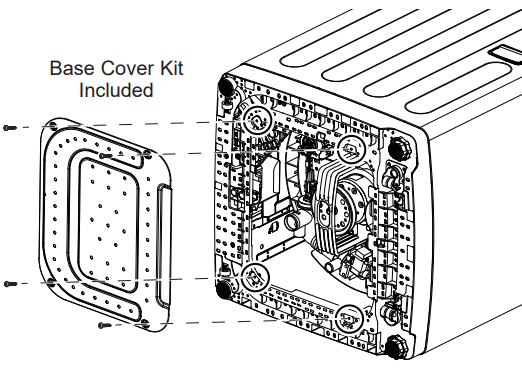
3. CONNECT DRAIN HOSE TO WASHER
Connect drain hose to drain port on back of washer. Open clamp with pliers and slide onto hose end. Holding clamp open, push hose end onto drain port until fully seated.
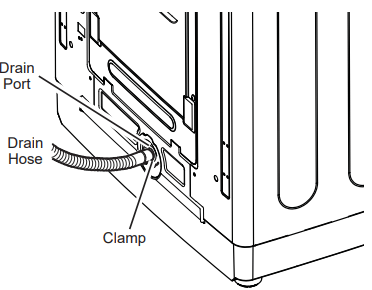
4. CONNECT WATER HOSES TO WASHER
Unplug electrical cord before installing water hoses. If not installed, install rubber washer in one end of hot water hose. Thread hot water hose onto red connection (right side). Hand tighten and use pliers to tighten hoses between 1/8 and 1/4 turn beyond hand-tight. If not installed, install rubber washer in one end of cold water hose. Thread cold water hose onto blue connection (left side). Hand tighten and use pliers to tighten hoses between 1/8 and 1/4 turn beyond hand-tight.
If not installed , install rubber washer in one end of cold water hose. Thread cold water hose onto blue connection (left side). Hand tighten and use pliers to tighten hoses between 1/8 and 1/4 turn beyond hand-tight
Move washer as close to final location as possible, leaving room for you to make water, drain, and electrical connections to your home.

5. CONNECT WATER HOSES TO OUTLET VALVES
Determine which is HOT water line before attaching water hoses to faucets. Traditionally, HOT faucet is on left. (If screen washers are not installed) With protruding part of screen toward you, install strainer screen/rubber washer into each of the free ends of two water hoses. Connect hot water hose to hot water outlet valve of your home. Hand tighten and use pliers to tighten hoses between 1/4 and 1/2 turn beyond hand-tight. Open hot water valve. Connect cold water hose to cold water outlet valve of your home. Hand tighten and use pliers to tighten hoses between 1/4 and 1/2 turn beyond hand-tight. Open cold water valve. Check for leaks and drips at the hose couplings. Tighten as necessary.

6. CONNECT TO DRAIN
Attach the drain hose to the drain outlet on the rear of the washer near the washer base. End furthest from the U-bracket should be attached to washer. Install the clamp on the drain hose and tighten to prevent leakage of water.
NOTE: If longer drain hose is required, order drain hose extension kit, GE Appliances part number WH49X316. Connect additional drain hose (contained in kit) to original hose with hose clamp (contained in kit).
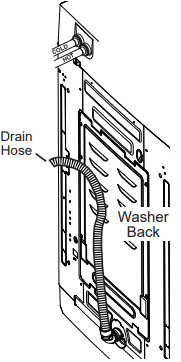
Insert remaining end of drain hose (shorter distance from U-bracket) into drain pipe or sink. IMPORTANT: There should be a minimum of 30” from the drain hose insertion point to the base of the unit.

NOTE: Placing the drain hose too far down the drain pipe can cause a siphoning action. No more than 5" of hose should be in the drain pipe. There must be an air gap around the drain hose. A snug fit can also cause a siphoning action.
7. REMOVE THE UNI-COUPLE® HOSE FROM INSIDE THE WASHER BASKET
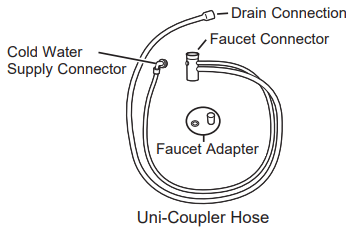
8. CONNECT TO WATER LINE
Attach the hose connector to the faucet adapter by pulling down on the locking collar while lifting up on the connector until it snaps into place. Make sure the water filter provided is in place
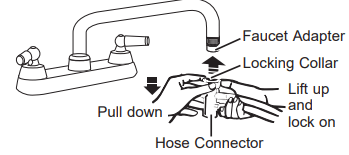
9. CONNECT TO VALVE INLET
Unplug electrical cord before installing water hose. If not installed, install rubber washer in one end of cold water hose. Thread cold water hose onto BLUE connection (left side).
NOTE: Only the cold valve will be connected for this installation. Hot valve should NOT be connected. Hand tighten and use pliers to tighten hoses between 1/8 and 1/4 turn beyond hand tight.
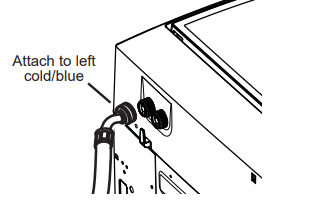
10. TIGHTEN CONNECTOR
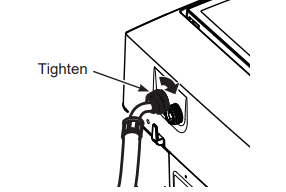
11. CONNECT DRAIN HOSE
Attach the drain connection side of the uni-couple hose to the rear of the washer. Install the clamp on the drain connection and tighten to prevent leakage of water
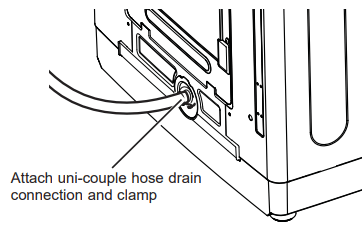
12 SET THE WASHER CONTROLS
Make sure that the Water Temp setting on the washer control panel is set to Cold since only the cold inlet is connected
13. SLOWLY TURN ON THE WATER FAUCET ALL THE WAY TO THE DESIRED WASH TEMPERATURE
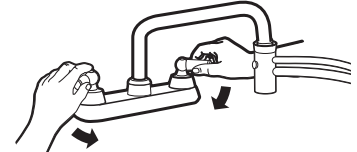
ELECTRICAL REQUIREMENTS
CIRCUIT – Individual, properly polarized and grounded 15 or 20 amp circuit breaker or time-delay fuse.
POWER SUPPLY – 2 wire plus ground, 120 Volt, single phase, 60 Hz, alternating current. Outlet Receptacle – Properly grounded 3-prong receptacle to be located so the power cord is accessible when the washer is in an installed position. If a 2-prong receptacle is present, it is the owner’s responsibility to have a licensed electrician replace it with a properly grounded 3-prong grounding type receptacle.
Washer must be electrically grounded in accordance with local codes and ordinances, or in the absence of local codes, with latest edition of the NATIONAL ELECTRICAL CODE, ANSI/NFPA NO. 70 or CANADIAN ELECTRICAL CODE, CSA C22.1. Check with a licensed electrician if you are not sure that the washer is properly grounded.
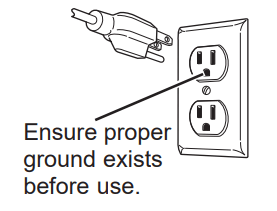
14 CONNECT POWER AND INSTALL
Insert plug of electrical cord into a 115V, 15- or 20-amp wall receptacle.
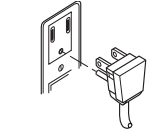
Move washer into final position. Place level on flat top side edges of washer. Adjust leveling legs until washer is level left-to-right and front-to-back. Remove level. Open tub lid. Remove and discard tub shipping material (see UNPACK THE WASHER section). Remove plastic protector film from the lid.
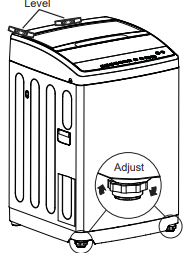
GROUNDING INSTRUCTIONS
This appliance must be grounded. In the event of malfunction or breakdown, grounding will reduce the risk of electric shock by providing a path of least resistance for electric current. This appliance is equipped with a cord having an equipment- grounding conductor and a grounding plug. The plug must be plugged into an appropriate outlet that is properly installed and grounded in accordance with all local codes and ordinances.
If required by local codes, an external 18 gauge or larger copper ground wire (not provided) may be added. Attach to washer cabinet with a #10-16 x 1/2” sheet metal screw (available at any hardware store) to rear of washer as illustrated.
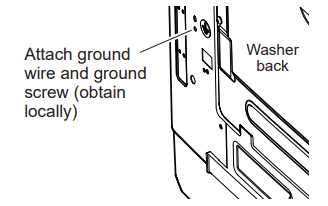
FINAL CHECKLIST
Before starting the washer, check to make sure:
- Main power is turned on.
- The washer is plugged in.
- The water faucets are turned on.
- The unit is level and leveling legs are firmly on the floor.
- The shipping foam is removed.
- The drain hose is properly tied up.
- There are no leaks at the faucet, drain line or washer.
Run the washer through a complete cycle.
- Check for water leaks and proper operation.
- Place these instructions in a location near the washer for future reference.
TROUBLESHOOTING TIPS
| Problem | Possible Causes | What To Do |
| Small amount of water remaining in dispenser (on some models) at end of cycle | Normal dispenser operation | It is normal for a small amount of water to remain in dispenser after the cycle. To empty water from dispenser drawer, remove drawer and dump water into washer basket or sink. Empty dispenser prior to putting detergent into dispenser for next cycle. |
| Water level seems low | This is normal | Water may not cover the top level of the clothes. This is normal for this high efficiency washer. |
| Low water flow | Water valve screens are stopped up | Turn off the water source and remove the water connection hoses from the upper back of the washer and the house water faucets. Clean both the hose screens (if so equipped) and the screens in the machine using a brush or a toothpick. Reconnect the hoses and turn the water back on. Check to ensure there are no leaks at the connections. |
| Water siphoning out of washer | Drain standpipe is too low or hose too far into standpipe | The drain hose must exceed 30” height at some point between the washer back and the drain pipe. Use anti-siphon clip. See the Installation Instructions. |
| Too many suds | Soft water | Try less detergent. |
| Too much detergent | Measure your detergent carefully. Use less soap if you have soft water, a smaller load or a lightly soiled load | |
| Type of detergent | Switch to High Efficiency detergent such as |
|
| Water leaks | Type of detergent | Switch to High Efficiency detergent such as |
| Using too much detergent in washer | Use less detergent. Use less soap if you have soft water, a smaller load or a lightly soiled load. | |
| Fill hoses or drain hose is improperly connected | Make sure hose connections are tight at faucets and rubber washers are installed. Make sure end of drain hose is correctly inserted in and secured to drain facility. | |
| Household drain clogged | Check household plumbing. You may need to call a plumber. | |
| Drain hose rubs on wall | Make sure drain hose does not make contact with the wall. May cause excessive wear on the hose. | |
| Constant water pressure to fill hoses at water source | Tighten hoses at the faucets. Check condition of the fill hoses; they should be replaced every 5 years. | |
| Water temperature seems incorrect | Cooler water temperatures provide improved energy efficiency | New laundry detergents have been formulated to work with cooler water temperatures without affecting wash performance. |
| Water supply is turned off or improperly connected | Turn both hot and cold faucets fully on and make sure hoses are connected to the correct faucets. NOTE: Cold water valve inlet is blue. Hot water valve inlet is red. | |
| Water valve screens are stopped up | Turn off the water source and remove the water connection hoses from the upper back of the washer and the water faucets. Clean both the hose screens (if so equipped) and the screens in the machine using a brush or a toothpick. Reconnect the hoses and turn the water back on. Check to ensure there are no leaks at the connections. | |
| Cool/Cold Water when selecting Hot | This is normal. The washer senses water temperature (on some models) and optimizes for best results. Cold water is added periodically when hot is selected | |
| House water heater is not set properly | Make sure house water heater is delivering water at 120°F–140°F (48°C–60°C). | |
| Water is pumped out before cycle is complete | Water was left in unit for 24 hours with lid closed or 15 minutes with lid open | Previous cycle has been canceled. Close lid, select new cycle, and start machine. |
| Water won’t drain | Drain hose is kinked or improperly connected | Straighten drain hose and make sure washer is not sitting on it. Top of drain outlet should be less than 8 ft (2.44 m) above floor |
| Washer spins and pauses at the beginning of cycles | This is normal | The washer is sensing the load |
| Washer pauses during wash cycle | The Soak Option was chosen | This is normal. The washer alternates between agitate and soak during these cycles to get your clothes cleaner with less wear. |
| This is normal | Many cycles incorporate as series of soaks within the agitation period to get your clothes clean with less wear. | |
| Residual powder in dispenser or clogging of dispensers | Wash water too cold or low home water pressure | Select a warmer wash temperature if possible to improve dissolving of detergent or use liquid detergent. Make sure siphon caps are free of debris and fully pressed into position. Remove and clean tray if clogging occurs. |
| Laundry additives dispensing too soon | Overfilling of dispensers | Do not overfill or add water to dispenser. Select Deep Rinse option when using fabric softener |
| Washer pauses during spin cycle | This is normal | The washer may pause during the spin cycle to remove soapy water more efficiently. |
| Washer won’t operate | Washer is unplugged | Make sure cord is plugged securely into a working outlet. |
| Water supply is turned off | Turn both hot and cold faucets fully on. | |
| Lid is open—safety feature prevents agitation and spinning when lid is up | Close lid and press Start. | |
| Circuit breaker/fuse is tripped/blown | Check house circuit breakers/fuses. Replace fuses or reset breaker. Washer should have a separate outlet. | |
| Electronics need to be reset | Unplug washer, wait 2 minutes, plug back in and press Start if display is active or press Power if unit is in idle (display blank) mode. | |
| Start was not pressed | Press Start | |
| Detergent packets not dissolving | Laundry detergent packet placed in dispenser | Laundry detergent packets should not be used in the dispensers. They should only be added directly to the wash basket following the manufacturer’s directions |
| Unexplained time and/or settings changes | Changing options | This is normal. Several options will change other options to maximize washer performance. |
| Colored spots | Incorrect use of fabric softener | Check fabric softener package for instructions and follow directions for using dispenser. Make sure you have selected the Deep Rinse option. Pretreat stain and rewash using Speed Wash cycle before drying. |
| Dye transfer | Sort whites or lightly colored items from dark colors. | |
| Grayed or yellowed clothes | Detergent amount | Be sure to follow detergent manufacturer’s directions |
| Hard water | Use a water conditioner or install a water softener | |
| Water is not hot enough | Make sure water heater is delivering water at 120°F–140°F (48°C– 60°C). | |
| Washer is overloaded | Loosely load clothes no higher than the top row of holes in the washer basket. For best results, load items around the outside of the basket | |
| Dye transfer | Sort clothes by color. If fabric label states wash separately, unstable dyes may be indicated. | |
| Lint or residue on clothes | Clothes are air or line dried | If you do not dry your clothes with a clothes dryer, your clothes may retain more lint |
| Incorrect sorting | Separate lint producers from lint collectors. | |
| Washing too long | Wash small loads for a shorter time using Light Soil setting. | |
| Detergent not dissolving | Rewash, next time: Try a liquid detergent; Use warmer water temperature. | |
| Overloading | Loosely load clothes in the washer basket. For best results, load items around the outside of the basket. | |
| Incorrect use of fabric softener | Check fabric softener package for instructions and follow directions for using dispenser. Make sure you have selected the Deep Rinse option. | |
| Clothes too wet | Incorrect cycle selected | Make sure the cycle selected matches the load you are washing. Some fabrics will feel wetter when rinsed with cold water. |
| Wash load out of balance | Redistribute load in washer and run through Spin cycle. | |
| Blinking Spin light or Spin light on at end of cycle | Out of balance condition has been detected | Allow cycle to continue and finish. If load is wet at the end of the cycle, even out load and run a Spin cycle. |
| Pilling | Result of normal wear on poly-cotton blends and fuzzy fabrics | While this is not caused by the washer, you can slow the pilling process by washing garments inside out. |
| Snags, holes, tears, rips or excessive wear | Pins, snaps, hooks, sharp buttons, belt buckles, zippers and sharp objects left in pockets | Fasten snaps, hooks, buttons and zippers. Remove loose items like pins, objects in pockets and sharp buttons. Turn knits (which snag easily) inside out |
| Undiluted chlorine bleach | Check bleach package instructions for proper amount. Never add undiluted bleach to wash or allow clothes to come in contact with undiluted bleach. | |
| Chemicals like hair bleach or dye, permanent wave solution | Rinse items that may have chemicals on them before washing. Use Speed Wash cycle with Extra Rinse option. | |
| Wrinkling | Incorrect wash and dry cycles | Match Cycle selection to the type of fabric you are washing (especially for easy care loads). |
| Improper sorting | Avoid mixing heavy items (like jeans) with light items (like blouses). Try a fabric softener. | |
| Overloading | Loosely load clothes in the washer basket. | |
| Repeated washing in water that is too hot | Wash in warm or cold water. | |
| Sounds | Possible Causes | Reason |
| “Clicking” | Shifter mechanism is engaging or disengaging | The drive system will engage at the start of agitate and disengage when agitate is complete. This occurs multiple times during the wash |
| Back and forth “swoosh” | Electric motor reversing direction | This sound is the motor rotating back and forth to clean your laundry |
| “Clicking” behind Control during fill | Automatic Temperature Control Valve | Two valves mix cold and hot water. The “clicking” is when either valve turns on or off to raise or lower the fill water temperature. |
| Water flow changes during fill | Automatic Temperature Control Valve | Two valves mix cold and hot water. The “clicking” is when either valve turns on or off to raise or lower the fill water temperature |
| Motor sounds during spin | Motor ramping up/down during spin cycle | The motor will speed up incrementally during the spin cycle. When spin is complete, it will coast until it stops. |
| “Humming” | Water drain pump | The drain pump will make a humming sound when pumping out water after agitation stops and continue until spin is complete |
| Drive motor | The drive motor will make a “humming” sound during the wash and spin phases of the cycle. | |
| “Gurgling” | Water drain pump | When the pump starts drawing in air, It starts to gurgle. The washer should then begin spinning and the sound will continue until it is done spinning. |
| Water “swishing” | Washing process | Water swishing, while the unit is agitating, is normal, especially with smaller loads. |
| Washer rocking/ moving and/or “knocking/tapping” | Washer leveling legs uneven | To level the washer, adjust the leveling legs by rotating the individual leg in the proper direction for up or down. |
| “Squeaking” sound | Washer not level and rubbing on cabinet | To level the washer, adjust the leveling legs by rotating the individual leg in the proper direction for up or down. |
See other models: JGB900CEK4CC ZVC36L2SS JD900BK3BB ZDP364NDP6SS AHM15AWW1
